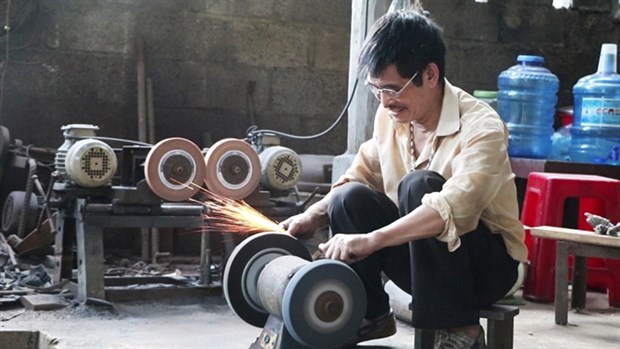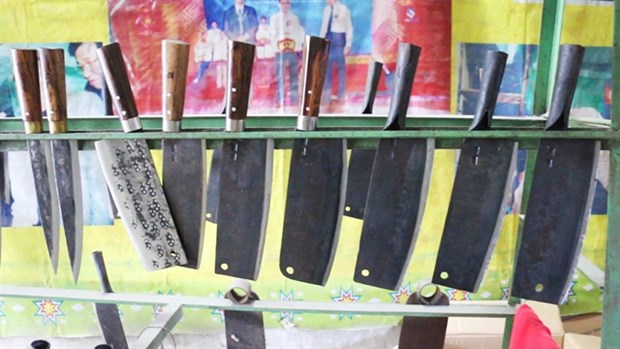 |
|
|
That noise is the sound of thousands of knives,of all shapes and sizes, being made each year by about 350 blacksmiths of the Nung ethnic minority.
During the day the village is filled with thesounds of workers beating and hammering steel as they forge knives usingtraditional techniques and recycled materials.
“We have been doing this job since mygrandparents’ time, and I don’t remember exactly when it started,” said58-year-old Long Anh Chien.
“We get steel from the shock absorbers of usedcars to make the knives,” he added.
Legend has it that the craft was first startedin the village about 200 years ago.
Nowadays some 200 households in Phuc Sen earn aliving forging knives.
An experienced blacksmith can make 4-5 knives aday, a less experienced one 3-4, Chien said.
Chien started learning to make knives when hewas 15. When he grew up he left the village to work elsewhere, but returned andtook up the traditional craft in 1998.
“I’ve done a lot of jobs but they were allunstable. This job does not pay as much as others, but it gives me something todo every day and a stable income,” he said.
“There are 12 workers in my workshop, dividedinto four groups of three. Each group is responsible for producing aspecific type of product. Knives, hammers, hoes, and rakes. Tools that serveagricultural production and domestic use.
“A senior blacksmith earns 15-20 millionVND (650-860 USD) a month. Those with less experience get 9-15 million VND permonth.”
 |
|
Knives are made and sold in Phuc Sen village, Cao Bang province
|
Despite the stable income, Chien said the job requires a lot of hard work and the mastery of emotions to do it well.
“With this job we all work 10 hours a day, not eight like other jobs. Ten hours and a lot of effort, technique and skill,” he said.
“A blacksmith has to be both aggressive andcalm. That’s what’s special about this job. If you’re being aggressive all thetime your products will all go to waste. If you’re calm all the time and doeverything slowly, the products will also not turn out well.
“Because the temperatures of fire fluctuate and decrease quickly. You have to be very quick to take advantage of the heat, that’s when your high temper comes into use. But then when you shape the knives you have to be very calm. Very calm and careful, otherwise your knives will notbe sharp.”
There are different steps to make a knife butLong Anh Minh, 47, said there are four major ones.
“The first step of making a knife is to choosethe steel. Then you temper the steel. Then you forge the knife, which is the most important step. The more carefully you do it, the higher quality your knife will be. Then you hone and shape it,” he said.
“The knives might be made from the same steel,but during the forging process, the longer you beat and hammer the knife, themore refined it will be since all the impurities have left.”
With some 20 years of experience in the trade,Minh said what makes Phuc Sen knives special is the manual forging process.
“I visited other knife village s and saw theblacksmiths there, while still using scrap steel from used cars like us, they use machines a lot and skip the manual steps when making the knives,” he said.
“Their knives might be sharp at first, but notfor long. How long the knife stays sharp depends on the manual forgingprocess.”
Requiring a lot of physical strength, makingknives may seem to be a job for men. But Minh’s wife helps him with themajority of the work, and he said he wants to pass the job on to his childrenand keep the traditional craft alive.
He said: “I live on the land where this craftwas born, so my entire family helps each other out.
“My children might not be old and strong enoughto forge knives, but they can help with small work. Like shaping the knives, which do not require much physical strength.
“This is a traditional job passed down to usfrom our ancestors. I hope my children will gradually take up the craft when they grow up.”/.VNA
 Phuc Sen village in the northern province of Cao Bang is not a place first-time visitors might want to stay long, as the noise may come as a shock.
Phuc Sen village in the northern province of Cao Bang is not a place first-time visitors might want to stay long, as the noise may come as a shock.